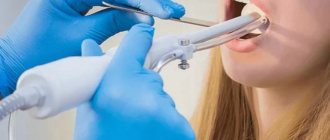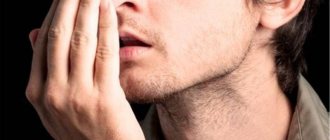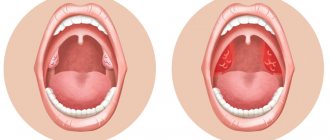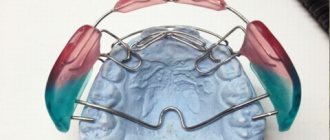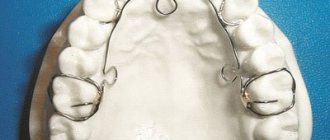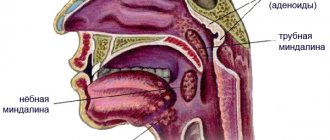01/18/2022
86 510
17 minutes
Co-author, editor and medical expert – Maksimov Alexander Alekseevich.
- Symptomatic treatment
- Rinsing
Many people are familiar with the diagnosis of tonsillitis. This unpleasant disease can take you by surprise and prevent you from leading a normal life. Tonsillitis is a pressing problem today, as it can occur at any age and with various diseases, such as herpes, diphtheria, streptococcal infections, scarlet fever and others. Often tonsillitis (or simply tonsillitis) acts as an independent disease. To understand the diagnosis and begin proper treatment, you need to consult a doctor. Remember that self-medication can lead to complications. What is tonsillitis? And how to cope with this disease? We will consider the answers to these questions below.
Up to contents
Symptoms:
- red, swollen tonsils with white or yellowish coating or streaks;
- a sore throat;
- difficult and/or painful to swallow;
- fever (temperature above 38.0);
- cervical lymph nodes are enlarged;
- hoarse or hoarse voice;
- headache;
- stiff neck muscles;
- abdominal pain (especially in young children).
In infants:
- drooling due to pain in swallowing;
- anxiety;
- refusal to eat
- With chronic tonsillitis, your breath may smell bad.
Treatment at home
To determine the diagnosis and begin treatment, contact your doctor. If you are diagnosed with acute tonsillitis, you must observe strict bed rest in the first days of the disease, then limit physical and psycho-emotional stress, which will help get rid of complications, among other things. The patient is given a personal plate, spoon, mug and, if possible, isolated. Prescribe non-irritating, soft foods, mainly plant-based, dairy, vitamin C, and plenty of warm drinks. Symptomatic therapy is also carried out: taking antipyretic, anti-inflammatory, painkillers.
Rinsing
Special attention should be paid to local therapy. Gargling with antiseptic solutions (Hexoral ® gargling solution) is useful for tonsillitis. The drug Hexoral ® has broad antibacterial activity, including against gram-positive microbes, is also active against the pathogenic genus of fungi Candida, and has an effect in the treatment of infections caused by Pseudomonas aeruginosa and Proteus. The antimicrobial effect of the drug is associated with the suppression of metabolism in bacteria, their oxidative reactions, without which the latter cannot exist (thiamine antagonist). At a concentration of 100 mg/ml, the drug inhibits the growth of most bacterial strains. The development of resistance to Hexoral ® is not observed. The active substance hexethidine has a mild analgesic effect on the mucous membrane of the pharynx and tonsils, can linger on it for a long time and is practically not absorbed. Therefore, it does not have a systemic effect. When using the drug Hexoral ®, regression of inflammatory changes in the pharynx may be observed5. It is recommended to use 15 ml of undiluted solution 2 times a day after meals, unless otherwise prescribed by a doctor. Before use, consult a specialist.
Rinsing is an effective method and an important component of the fight against tonsillitis, which can be successfully used in home treatment. Rinsing with a salt solution, irrigating the oropharynx with sprays with sea water, a decoction of chamomile, sage, chlorhexidine and other antiseptics help well. Rinsing with solutions at body temperature (36-37 degrees) reduces inflammation, mechanically cleanses the mucous membrane of the oropharynx from viruses, bacteria, pus, helps relieve swelling, and as a result, reduce sore throat. Rinsing is completely safe for children, pregnant women and nursing mothers.
Washing the lacunae of the tonsils with antiseptics is used for many types of both acute and chronic tonsillitis. The most common method of washing the lacunae of the tonsils is according to N.V. Belogolov. and Ermolaev V.G1. This effective procedure is performed by an otolaryngologist. Under the control of pharyngoscopy, the doctor sequentially inserts a thin cannula through each lacuna into the crypt of the tonsil, and with a syringe filled with an antiseptic, under pressure washes out everything unnecessary from the lacuna. As a rule, 2-3 crypts of the upper part of the tonsil are washed. All tonsil crypts are usually connected to each other, so the entire tonsil is washed and drained. After this, the treated mucous membrane is lubricated with Lugol’s solution, iodine, and 5% collargol. The positive effect of the procedure is achieved by mechanically flushing the lacunae from pus and restoring their drainage function. Treatment is carried out in a course of 10-15 washes, which are prescribed every other day.
Complications of tonsillitis
- Labored breathing.
- Sleep apnea (holding your breath during sleep).
- Spread of infection to the tissue near the tonsils (peritonsillitis), peritonsillar abscess - accumulation of pus behind the tonsil.
- Acute cervical lymphadenitis is inflammation of the cervical lymph nodes.
Streptococcal tonsillitis can cause complications such as:
- acute rheumatic fever, affecting the joints, heart and other organs;
- glomerulonephritis (inflammation of the kidneys, which can lead to serious consequences, including kidney failure).
Treatment with antibiotics significantly reduces the likelihood of complications after streptococcal sore throat.
How is the procedure performed?
All rinsing methods are based on exposing the tonsils to a stream of disinfecting solution or vacuum. Cleaned tonsils are treated with medications.
Processing each tonsil takes from 30 seconds to 1.5 minutes. The time depends on the choice of type of cleaning of the lacunae and the depth of damage to the lacunae.
Important! Before the procedure, you cannot eat for 1.5-2 hours. This is due to the fact that rinsing provokes a gag reflex.
To prevent possible discomfort, the doctor treats the tonsils with a local anesthetic with lidocaine or novocaine in the form of a spray.
Diagnosis of tonsillitis
- For tonsillitis, the doctor will examine the child's throat, as well as his ears and nose, where there may also be inflammation.
- The doctor will examine the child's skin, since streptococcal sore throat sometimes causes a specific rash. This is what is called “scarlet fever” - it is not some kind of separate disease, but a sign of damage to the body by streptococcus.
- The doctor will feel the cervical lymph nodes - as a rule, with tonsillitis they swell.
- The doctor will feel the spleen to distinguish a sore throat from mononucleosis, which also causes swollen lymph nodes.
- The streptococcal test is a simple and accurate way to distinguish streptococcal tonsillitis from viral tonsillitis. The doctor takes a scraping from the child’s throat and within 24-48 hours the result is ready.
- In some cases, a general blood test may be needed, the results of which can also indicate the viral or bacterial nature of the disease. It is usually taken if the streptococcal test is negative, but the course of the disease leaves the doctor in doubt.
About the clinic
Euromed Clinic is a multidisciplinary family clinic in the center of St. Petersburg.
- Calling a doctor to your home
- 24/7 therapist appointment
- Tests, ultrasound, x-ray
- Whole body diagnostics
- Hospital and surgery
- Vaccination
Find out more about the clinic
Rinsing the tonsils with a syringe
This method is the most common and accessible. It will be offered to you at the local clinic. The essence of the technique is as follows: an ENT doctor, using a needle-free syringe, injects an antiseptic drug into the lacunae of the tonsils, which, together with the purulent masses from the lacunae, is washed into the patient’s oral cavity. The patient spits the solution into a special tray, and the ENT doctor repeats the procedure. Upon completion, the tonsils are lubricated with Lugol's solution.
The disadvantage of the procedure is that it is not possible to thoroughly rinse the lacunae, since the openings in the tonsils are very narrow. This rinsing helps with minor purulent accumulations.
The manipulation should be carried out by an experienced ENT doctor. Inept movements can injure the walls of the tonsils, which will only worsen the patient’s condition.
Recently, in modern ENT clinics this technique is used less and less, mainly in cases where the patient has a pronounced gag reflex.
It is much more effective to rinse the tonsils using a vacuum method using the Tonsillor apparatus.
Treatment of tonsillitis
The child should be provided with:
- peace and the opportunity to sleep as much as he wants;
- Drink plenty of fluids to relieve sore throats and prevent dehydration;
- air humidification;
- a sore throat can be relieved by both warm drinks and cold ice cream, especially popsicles;
- for a sore throat, it helps to gargle with a solution of table salt and soda - a teaspoon of salt and a small pinch of soda per 250 ml of warm water;
- Children over 4 years old can be offered lozenges for sore throats. Do not give candy to small children - they may choke;
- do not smoke when your child is sick, avoid strong odors that irritate the throat;
- A sore throat and fever can be relieved by medications containing paracetamol and ibuprofen. Don't give children aspirin; in rare cases, it can cause deadly Reye's syndrome.
Confirmed bacterial tonsillitis (usually streptococcal tonsillitis) is treated with antibiotics. It is dangerous to interrupt or stop the course because it increases the likelihood of infection spreading to the joints, heart, kidneys and other organs. Continue taking antibiotics even if your symptoms are completely gone.
Remove or treat?
Among experienced patients, there are many stories from the series: “Previously, the problem was solved simply - you just need to remove the tonsils, and life will sparkle with bright colors.” Many patients purposefully come to an ENT doctor with a request to get rid of tonsils once and for all. However, many do not understand that by removing such an important organ of the immune system, a person is deprived of a natural barrier against infection. Yes, the problem of tonsillitis will disappear, but other diseases, for example, of the respiratory tract, will take their place. Bacteria and viruses will be able to freely enter the body, causing inflammation of other human organs and systems.
To remove tonsils according to indications, you need:
- often have a sore throat (more than four times a year);
- have a history of peritonsillar abscess;
- have poor rheumatic test scores;
- diagnose complications in your heart, kidneys or joints.
If there are no direct indications for removal, you need to contact an otolaryngologist to prescribe competent complex therapy, which will significantly increase the duration of remission and reduce the number of exacerbations.
One of the most effective procedures for treating tonsillitis, which avoids removal, is washing the palatine tonsils.
Causes of development of chronic tonsillitis
The development of chronic tonsillitis is possible according to 2 scenarios:
- as a result of tonsillitis (acute tonsillitis), which was incorrectly treated or the treatment was not completed;
- as a result of decreased immune defense and constant exposure to aggressive factors (this is a non-anginal option).
The following are aggressive stimuli:
- inhalation of tobacco smoke;
- poor nutrition;
- alcohol abuse;
- carious teeth;
- inflammatory processes in the paranasal sinuses (sinusitis, sinusitis, etc.);
- impaired nasal breathing that occurs when the nasal septum is deviated, polyps or hypertrophy of the inferior turbinates. Under such conditions, the oral mucosa dries out and the formation of immunoglobulin A is disrupted, which reduces the immune defense of the ENT organs.
However, exposure to the described factors alone is not enough for the development of chronic tonsillitis. Currently, it is considered the result of infection with pathogenic bacteria against the background of allergization (altered immune reactivity). Local changes in the lymphoid tissue after previous tonsillitis, as well as the factor of heredity, which manifests itself only under certain conditions of the internal and external environment, also have a role in this process.
Infection. The most common causes are streptococci and staphylococci. In this case, the maximum danger is posed by pyogenic streptococcus, which is called beta-hemolytic (belongs to group A). The risks associated with this pathogen are the likelihood of developing autoimmune diseases, i.e. when your own immune cells damage other cells in your body. This happens with glomerulonephritis, rheumatism, polyarthritis and other similar diseases.
Altered reactivity of the body (its allergization), which is characterized by excessive production of class E immunoglobulins. Under such conditions, the re-entry of antigens (for example, foreign bacterial proteins) triggers an allergic reaction that constantly maintains inflammation. This corresponds to the exacerbation phase of the pathological process.
It has been proven that the likelihood of chronic tonsillitis in people whose first- or second-degree relatives suffered from this disease is much higher than in other people. This is due to the peculiarities of the anatomy of the tonsillar crypts and immune status (tendency to an allergic response).
Contraindications
Treatment of lacunae is not prescribed for patients with:
- exacerbation of other chronic diseases, including caries;
- cancer diagnoses;
- in the 1st and 3rd trimester of pregnancy;
- pathology of the retina;
- severe pathologies of the heart and blood vessels;
- up to 3 years of age.
For hypertension, consultation with a specialized specialist is required.
Important! It is necessary to warn the doctor about any existing individual intolerance to drugs.
How to wash tonsils at home
Antiseptic and antibacterial drugs are used to treat the tonsils. With their help, it is possible to eliminate the source of infection, as well as relieve inflammation. The following tools can be used for the procedure:
- saline;
- alcohol-containing solutions;
- furatsilin;
- soda-salt solution with the addition of a few drops of iodine;
- herbal decoctions.
Your doctor will help you determine the appropriate product for irrigating your tonsils.
What is the Tonsillor device?
"Tonsillor - 3MM" is used for the conservative and surgical treatment of diseases of the ENT organs through the combined effects of ultrasound, vacuum and ozone/NO-containing medicinal substances on the affected tissues.
Ultrasound, which has healing properties, allows for anti-inflammatory and resorption therapy, pain relief, improves blood microcirculation at the site of exposure, cleans wounds of necrotic tissue and bacterial contamination and creates a drug depot at the site of the lesion. Under the influence of ultrasound, trophism, blood supply to tissues, metabolism improve, and local immunity is stimulated.
Features of each technique
Despite the fact that the use of a syringe can significantly reduce the cost of treating the infected area, the method also has several significant disadvantages. The most important of them is the increased risk of injury, since if the doctor lacks experience, there is a high risk of causing microtrauma with a metal cannula.
If the doctor accidentally made a puncture, then this will result in prolonged healing, which, against the background of a general infection, will generally occur extremely slowly. A scar remains as an eternal reminder, which during the next exacerbation of chronic tonsillitis will become a significant obstacle to the outflow of fluid.
It turns out to be a vicious circle: the patient will get sick again, will come to the appointment again for syringe rinsing due to the inability of the tonsils to independently organize the outflow of fluid. Thus, even initially, for the first time, people who become ill can enroll in the circle of chronic patients.
Another difficulty may be the anatomical structure of the treated area. Due to the tortuosity, reaching all corners of the curved passages will be quite problematic. This increases the percentage probability that the infection will remain stuck for a long time at a practically inaccessible point, constantly making itself known after the condition has partially improved.
Against this background, many victims choose a hardware approach, which involves a higher cost. It also has a number of contraindications, among which pregnancy is especially prominent. When a woman in an interesting situation becomes a victim of a sore throat, she will be sent for treatment using syringe rinses that are safer for the fetus.
At the same time, vacuum intervention is ready to provide a more sustainable effect compared to its outdated counterpart. The method also allows you to almost completely eliminate the risks of a possible accidental puncture of part of the larynx. Regardless of the chosen measure, it is imperative to pay attention to the absolute prohibitions for implementing manipulation. These include:
- acute infectious diseases with elevated body temperature;
- oncological neoplasms of any location;
- tuberculosis.
A relative contraindication would be those people whose gag reflex is pronounced. If you manage to endure it the first time, then, as reviews indicate, in subsequent times the deficiency manifests itself much weaker.
